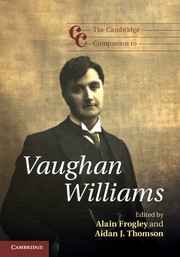28 results
Chapter 1 - London and the Modern City
- from Part I - Biography, People, Places
-
-
- Book:
- Vaughan Williams in Context
- Published online:
- 28 March 2024
- Print publication:
- 04 April 2024, pp 11-18
-
- Chapter
- Export citation
Chapter 32 - Reception in the USA:
- from Part VI - Reception
-
-
- Book:
- Vaughan Williams in Context
- Published online:
- 28 March 2024
- Print publication:
- 04 April 2024, pp 276-282
-
- Chapter
- Export citation
Chapter 19 - Britten and the English Musical Renaissance
- from Part III - Britten and Other Composers
-
-
- Book:
- Benjamin Britten in Context
- Published online:
- 31 March 2022
- Print publication:
- 21 April 2022, pp 163-170
-
- Chapter
- Export citation
Modernism and its Discontents: Reclaiming the Major Minor British Composer
-
- Journal:
- Journal of the Royal Musical Association / Volume 143 / Issue 1 / 2018
- Published online by Cambridge University Press:
- 01 January 2020, pp. 243-254
- Print publication:
- 2018
-
- Article
- Export citation
The Cambridge Companion to Vaughan Williams - Half title page
-
- Book:
- The Cambridge Companion to Vaughan Williams
- Published online:
- 05 December 2013
- Print publication:
- 14 November 2013, pp i-0
-
- Chapter
- Export citation
Select bibliography
-
- Book:
- The Cambridge Companion to Vaughan Williams
- Published online:
- 05 December 2013
- Print publication:
- 14 November 2013, pp 321-325
-
- Chapter
- Export citation
Series page
-
- Book:
- The Cambridge Companion to Vaughan Williams
- Published online:
- 05 December 2013
- Print publication:
- 14 November 2013, pp i-ii
-
- Chapter
- Export citation
Part III - Activism, reception and influence
-
- Book:
- The Cambridge Companion to Vaughan Williams
- Published online:
- 05 December 2013
- Print publication:
- 14 November 2013, pp 229-320
-
- Chapter
- Export citation
General index
-
- Book:
- The Cambridge Companion to Vaughan Williams
- Published online:
- 05 December 2013
- Print publication:
- 14 November 2013, pp 330-338
-
- Chapter
- Export citation
Contents
-
- Book:
- The Cambridge Companion to Vaughan Williams
- Published online:
- 05 December 2013
- Print publication:
- 14 November 2013, pp vii-viii
-
- Chapter
- Export citation
Part I - ‘Who wants the English composer?’: forging a path, 1890–1925
-
- Book:
- The Cambridge Companion to Vaughan Williams
- Published online:
- 05 December 2013
- Print publication:
- 14 November 2013, pp 7-78
-
- Chapter
- Export citation
Tables
-
- Book:
- The Cambridge Companion to Vaughan Williams
- Published online:
- 05 December 2013
- Print publication:
- 14 November 2013, pp ix-ix
-
- Chapter
- Export citation

The Cambridge Companion to Vaughan Williams
-
- Published online:
- 05 December 2013
- Print publication:
- 14 November 2013
List of abbreviations
-
- Book:
- The Cambridge Companion to Vaughan Williams
- Published online:
- 05 December 2013
- Print publication:
- 14 November 2013, pp xvi-xvi
-
- Chapter
- Export citation
Introduction
-
-
- Book:
- The Cambridge Companion to Vaughan Williams
- Published online:
- 05 December 2013
- Print publication:
- 14 November 2013, pp 1-6
-
- Chapter
- Export citation
Part II - Works by genre
-
- Book:
- The Cambridge Companion to Vaughan Williams
- Published online:
- 05 December 2013
- Print publication:
- 14 November 2013, pp 79-228
-
- Chapter
- Export citation
The Cambridge Companion to Vaughan Williams - Title page
-
-
- Book:
- The Cambridge Companion to Vaughan Williams
- Published online:
- 05 December 2013
- Print publication:
- 14 November 2013, pp iii-iii
-
- Chapter
- Export citation
Acknowledgements
-
- Book:
- The Cambridge Companion to Vaughan Williams
- Published online:
- 05 December 2013
- Print publication:
- 14 November 2013, pp xiii-xv
-
- Chapter
- Export citation
Contributors
-
-
- Book:
- The Cambridge Companion to Vaughan Williams
- Published online:
- 05 December 2013
- Print publication:
- 14 November 2013, pp x-xii
-
- Chapter
- Export citation
Copyright page
-
- Book:
- The Cambridge Companion to Vaughan Williams
- Published online:
- 05 December 2013
- Print publication:
- 14 November 2013, pp iv-iv
-
- Chapter
- Export citation



